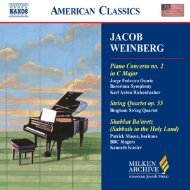Download Liner Notes PDF - Milken Archive of Jewish Music
Download Liner Notes PDF - Milken Archive of Jewish Music
Download Liner Notes PDF - Milken Archive of Jewish Music
You also want an ePaper? Increase the reach of your titles
YUMPU automatically turns print PDFs into web optimized ePapers that Google loves.
the pathbreaking recording Birth <strong>of</strong> the Cool, gives Wolpecredit for helping with the piece. In turn, Wolpe modeledthe scoring <strong>of</strong> his Quartet for Trumpet, Tenor Saxophone,Percussion and Piano on Carisi’s Counterpoise no. 1.With the poet Hilda Morley (who became his third wife),Wolpe began in 1950 to attend meetings <strong>of</strong> the EighthStreet Artists’ Club, where he became close friends withFranz Kline, Willem and Elaine de Kooning, Mark Rothko,Jack Tworkov, and Esteban Vincente. As music director atBlack Mountain College (1952–56), Wolpe enjoyed a milieu<strong>of</strong> artists, craftsmen, and poets that reminded him <strong>of</strong> theBauhaus. While at the rural campus in North Carolina, hecomposed several <strong>of</strong> his most important scores—Enactmentsfor Three Pianos; Piece for Oboe, Cello, Percussion andPiano; and the Symphony—in which he said he aimed for“a very mobile polyphony in which the partials <strong>of</strong> the soundbehave like river currents and a greater orbit-spreadoutis guaranteed to the sound, a greater circulatory agility(a greater momentum too).” These works <strong>of</strong> exuberantcomplexity mark the high point <strong>of</strong> musical actionism.During the 1950s Wolpe wrote a series <strong>of</strong> lectures in whichhe discusses music in the imaginative and constructivemanner <strong>of</strong> the Bauhaus masters. He proposes that thetheory <strong>of</strong> music should be concerned with fantasy asmuch as with technique, because the material is as mucha product <strong>of</strong> the creative imagination as it is <strong>of</strong> therational intellect. At the Summer Course for New <strong>Music</strong> atDarmstadt in 1956 he presented a survey <strong>of</strong> current trendsin the United States. After tributes to Varèse and Coplandhe discussed the music <strong>of</strong> Milton Babbitt, Earle Brown,John Cage, Elliott Carter, Morton Feldman, and ChristianWolff. Wolpe responded to the Webern revival by studyingclosely the later scores <strong>of</strong> his former teacher, and he becamegreatly interested in the music <strong>of</strong> Boulez and Stockhausen.He summed up his poetics in the lecture “Thinking Twice,”in which he presents his ideas on serialism, organic modes,and the interplay <strong>of</strong> complementary qualities as the basis fora nondevelopmental discontinuum—“the ever-restored andever-advancing moment.”After the exuberant and extensive scores <strong>of</strong> the BlackMountain period, Wolpe began to refine and focus hismeans, as in his Form for Piano, and like some painters <strong>of</strong>the period, he titled many works simply as Piece or Form.Images, shapes, and gestures are succinct and sharplycontrasted in fully notated yet intuitively composedmoment form. Many <strong>of</strong> the pieces from the 1960s are intwo parts, thus projecting complementarities on both themicro and macro level. One part is generally slower, with agathering centering action; the shapes are well formed; theexposition is sometimes reprised; and the mode <strong>of</strong> thoughtis directed, orderly, and stable. The other part, however, isgenerally faster, with the action scattering and dispersing,and the mode <strong>of</strong> thought disruptive and dissociated.Disorder is included as the limiting case <strong>of</strong> order, but thechaotic passages are written out and not left to chance. Inhis last pieces Wolpe revisited historical forms. From Hereon Farther, subtitled Concerto, has a ritornello design, andPiece for Trumpet and Seven Instruments includes elements<strong>of</strong> the solo concerto form.For Wolpe, composing was a process <strong>of</strong> discovery.Precompositional charts prepare for the spontaneousoutflow <strong>of</strong> the creative imagination. His music thusevades rational criteria <strong>of</strong> form and style, for he engagesvaried types <strong>of</strong> syntax and “levels <strong>of</strong> language”—fromthe colloquial to the poetic, from the quotational to thepersonal, and from the orderly to the dangerously chaotic.He trusted his unique form-sense to combine disparateimages into structures that have an intuitive coherence.Wolpe, like Busoni and the masters <strong>of</strong> the Bauhaus,regarded teaching as an obligation, not merely as alivelihood. In Palestine and thereafter in America he passedon his unique vision <strong>of</strong> music to succeeding generations<strong>of</strong> composers. Some had careers in radio, television, film,and musical theater (Stanley Applebaum, Elmer Bernstein,Kenyon Hopkins, Mike Stoller); others in modern jazz;and still others in concert music (Herbert Brun, MortonFeldman, Ralph Shapey, David Tudor). In 1957 Wolpe tookup the position <strong>of</strong> pr<strong>of</strong>essor <strong>of</strong> music at C. W. Post College,11 8.559439
















